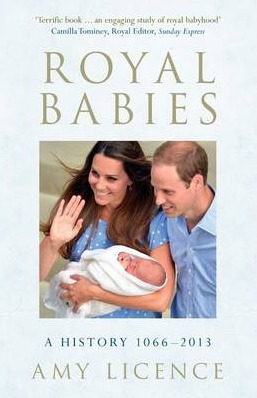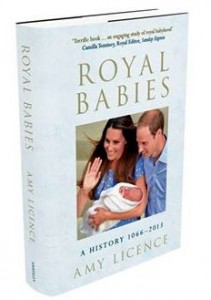 Royal Babies – A History is the story of twenty-five births, from the arrival of Princess Matilda in 1066, whose claim to the throne tore England apart in the years of the Anarchy, to the reign of the Windsors as the world eagerly awaited the arrival of Prince George earlier this year. Not only does it explore the political impact of each baby’s arrival, it tells the story of those who brought them into the world. A fascinating insight into the history of childbirth, the impact of morality and superstition on medicine and how it evolved over the years, and the women in the delivery room, mother and midwife.
Royal Babies – A History is the story of twenty-five births, from the arrival of Princess Matilda in 1066, whose claim to the throne tore England apart in the years of the Anarchy, to the reign of the Windsors as the world eagerly awaited the arrival of Prince George earlier this year. Not only does it explore the political impact of each baby’s arrival, it tells the story of those who brought them into the world. A fascinating insight into the history of childbirth, the impact of morality and superstition on medicine and how it evolved over the years, and the women in the delivery room, mother and midwife.
We spoke to historian Amy Licence about the babies whose births and deaths changed British history.
In Royal Babies you describe medieval ideas about conception and fertility, medical practices and herb lore. Your first book, In Bed with the Tudors, also discussed childbirth during the reigns of the Tudor monarchy. What drew you to researching this particular area of history?
Actually, what drew me to study childbirth in the past was going through the process myself. I’ve always been interested in women’s history but after I had my first son in 2010, I met lots of other new mothers and heard their birth stories; each was very different but they also had many similarities. Hearing about their experiences made me wonder about women from past eras and how they coped without pain relief and who cared for them, in what ways. I was also aware of how lucky I had been having a relatively straightforward delivery and was very grateful to be in a modern hospital; I couldn’t imagine having to just get on with it, wherever I happened to be at the time, as some women did, so I wanted to know more about their stories.
You have studied some very famous royal offspring and some that are relatively unknown. How did you go about choosing your subjects?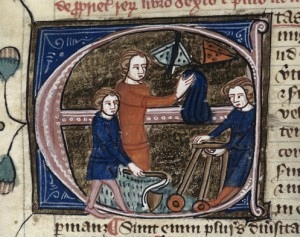
It wasn’t easy to choose, as there are so many fascinating royal births but I wanted a mixture of some who became King or Queen, as well as some that did not make it. I suppose that highlights the randomness of fate; at the moment of birth, the parents and the nation have no idea what will happen in the future, it is only hindsight that informs us of their destinies, so I wanted to recapture some of the hopes felt for these children and put some of the lost babies back on the map. Apart from that, I simply chose ones that most interested me, some I already knew a lot about, such as those born in the medieval and Tudor period and others belonging to earlier or later times, that were completely new to me.
 You’ve included passages from various medical texts in Royal Babies. Some seem to include very practical advice, like the 9th century Bald’s Leechbook, which advises not to drink to excess, to avoid certain foods and strenuous exercise, while others include some rather strange herbal concoctions and superstitions. What are some of the more surprising things you’ve come across in your research?
You’ve included passages from various medical texts in Royal Babies. Some seem to include very practical advice, like the 9th century Bald’s Leechbook, which advises not to drink to excess, to avoid certain foods and strenuous exercise, while others include some rather strange herbal concoctions and superstitions. What are some of the more surprising things you’ve come across in your research?
Yes, I’ve been fascinated by the advice that has been offered to expectant mothers over the centuries, ranging from that which seems fairly sensible such as resting and bathing to relax, to the downright bizarre. I had thought that the oddest advice would be earlier on in history and that as the centuries went on, medical texts would speak more sense but some of the oddest things I read belonged to the eighteenth century, which advised against babies being fed breastmilk and doctors being quite confident that pregnancies could run up to ten or eleven months long, because, according to one manual, different men’s “seed” ripened at different speeds.
While the male doctors looked after the Queen during her pregnancy, they were most commonly excluded from the delivery room, with the midwives attending the actual birth. Was there some rivalry between doctors and midwives?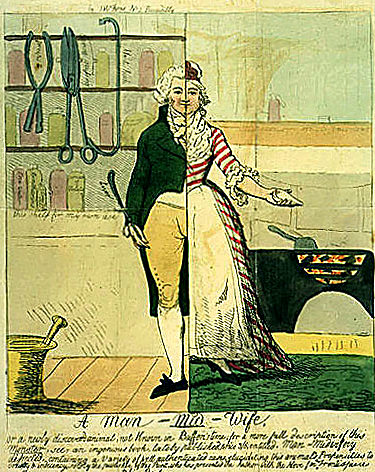
Absolutely! For many centuries, they were kept outside locked doors and the women did the job. There was conflict between them as a result, which spilled over into cartoons and drama, literature and pamphlets of the day. It really came to a peak in the late eighteenth century, with the male “accouchers” becoming fashionable among society women, but as many of the published midwives of the day wrote, their experience was theoretical in comparison with a woman’s practical, hands-on knowledge. So there are many cases, sadly, of men failing to intervene in difficult labours or doing so with poor anatomical knowledge and causing mutilation and death. This wasn’t always the case; there were some very good male doctors but there was a real tension between the sexes, as men were seen to be moving in to one of the only female areas of medicine. I found this to be one of the most interesting aspects of researching this book.
BBC’s The White Queen has shown several scenes depicting birth. We’ve seen Elizabeth Woodville give birth standing, being “walked” and recently the mention of “tossing the Queen in a blanket”. Do you think they gave an accurate interpretation?
Yes, there is an element of accuracy there, although, of course, the time-frame has been sped up so we don’t get a sense of the long hours of labour that many women must have endured, anything from several hours to several days. It was most common for women at that time to deliver their babies in a standing position, as gravity was on their side and they were advised to walk about gently to get the baby moving. Tossing a mother in a blanket was a last resort and I’ve never come across an example of it actually happening; perhaps it was one of those old wives’ tales, perhaps even designed to startle a mother at the thought of it. It can’t be ruled out though; some texts do recommend strange things, such as holding her upside down or firing arrows above the house, which was supposed to help. I think they must have felt so helpless when things started to go wrong, that they would try anything.
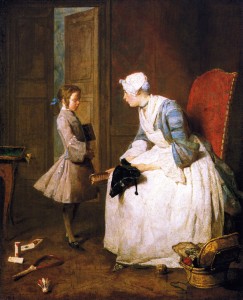 In medieval times royal children had their own attendants, some had their own separate households. I imagine it would have been a very desirable position to obtain, who was responsible for choosing the infant’s nurses and attendants and how did they go about it?
In medieval times royal children had their own attendants, some had their own separate households. I imagine it would have been a very desirable position to obtain, who was responsible for choosing the infant’s nurses and attendants and how did they go about it?
It would have been a lucrative position and was given to someone whom the parents trusted very much. They would appoint a governor or governess to overview the household, often from within their own family or circle, or else someone with a reputation for piety or learning, sometimes their own old nurses. Within the household, a baby would have rockers, (literally rocking the cradle) which was a fairly junior position but most important was the wet nurse. These were chosen very carefully, according to appearance, which they thought was correlative with health. It would usually have been a lower class woman, ideally from within the Queen’s employ but if not, they would select carefully from the local area and selected for her clear skin and good teeth, who had rosy cheeks and the appearance of health. She should also have a good reputation, be moral and religious, not drink too much and of course, needed to have borne a child herself fairly recently. It was thought that a baby would absorb the character of their nurse through her milk. There were professional midwives in operation but these did not always have a good reputation so the King and Queen would have several candidates lined up and checked out before their offspring arrived, knowing that its life could depend upon it.
When did royal women start taking a more hands-on approach to raising their children?
Only very recently, in the late twentieth century. Raising children wasn’t seen as compatible with a Queen’s duties and the need to provide more heirs, so the model of parenting we recognise today only really began with the current Queen’s childhood. Hers was a close knit family unit, before her father, George VI, became King, but typically of the 1920s and 30s, the children still had set hours to spend with their parents. Often they came together for an hour or so at tea time. It was Princess Diana who really advocated modern parenting in spending more time with her sons and taking a more practical, hands-on approach. Each generation from the twentieth century onwards have closed the gap between royal parent and child a little.
One story in the book struck me in particular, the story of Charlotte and Leopold’s stillborn son George and her subsequent death. It seems that the dangers of childbirth did not diminish a great deal until the 20th century. Why do you think it took such a long time to make advancements, was there perhaps a sense of complacency when it came to childbirth?
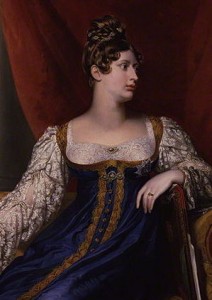 Yes, it is a tragic story and one that I found very moving to research and write about. I think this was one of those occasions when nineteenth century decorum and fashion got in the way. Charlotte may well have survived her ordeal had a doctor or midwife physically intervened early on, when her son was stuck. Yet she had a male doctor, and the idea of touching a royal woman intimately was a real taboo, even in a case like this. It seems ridiculous to us now but there were cases of women and their babies dying because they refused essential examinations and although I don’t think Charlotte refused, I can’t help wondering whether an experienced woman would have simply got her hands in and pulled the baby out. The complacency question is an interesting one; I suspect there was a sense of fate, with such high infant and maternal mortality. They believed that loss was an inevitable factor in a percentage of cases, perhaps predetermined, rather than something that could be prevented. It may be that this resignation was one way of coping with loss. Then again, there is always the chance that Charlotte would not have survived even if intervention had occurred, we simply don’t know. It was a triple tragedy, claiming the life of her doctor too and changing the direction of British history.
Yes, it is a tragic story and one that I found very moving to research and write about. I think this was one of those occasions when nineteenth century decorum and fashion got in the way. Charlotte may well have survived her ordeal had a doctor or midwife physically intervened early on, when her son was stuck. Yet she had a male doctor, and the idea of touching a royal woman intimately was a real taboo, even in a case like this. It seems ridiculous to us now but there were cases of women and their babies dying because they refused essential examinations and although I don’t think Charlotte refused, I can’t help wondering whether an experienced woman would have simply got her hands in and pulled the baby out. The complacency question is an interesting one; I suspect there was a sense of fate, with such high infant and maternal mortality. They believed that loss was an inevitable factor in a percentage of cases, perhaps predetermined, rather than something that could be prevented. It may be that this resignation was one way of coping with loss. Then again, there is always the chance that Charlotte would not have survived even if intervention had occurred, we simply don’t know. It was a triple tragedy, claiming the life of her doctor too and changing the direction of British history.
How do you think the women of the royal family fare today compared to their predecessors in terms of public scrutiny?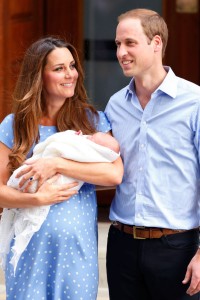
Even though it may seem to us that there are cameras everywhere the current royal family go, even camped outside the hospital where the Duchess of Cambridge gave birth, she still has far more privacy than her predecessors. Until the 1940s it was common for the Prime Minister to be present, initially at the bedside, but later on, in the building, to act as a witness. Before that, some queens suffered the indignity of having their bedchambers crowded with MPs and ambassadors, all keen to observe the safe delivery of a child and report any suspicious circumstances. For Mary of Modena in 1688, with her room filled with such witnesses, the distrust of her people must have been difficult to bear. It must have brought home to her and others, just how far her queenship denied her any privacy and that her body was a vessel of the state.
You’ve had two biographies published this year on Anne Neville and Elizabeth of York, and you also appeared on BBC’s The Real White Queen and her Enemies documentary. What can we expect next? Will you be continuing to research the Wars of the Roses period?
Yes, I am working on two new books at the moment, a biography of Cecily Neville, mother of Kings Edward IV and Richard III, which will look at her long and varied life and those of her children and grandchildren. The way which she outlived most of her offspring and witnessed them turn against each other makes for an interesting story. I am also doing a shorter book on Richard III himself, which is half biography and half looking at the events surrounding the discovery of his bones and the controversy surrounding his re-interment, wherever that may turn out to be. Both will be out in the spring of next year.
 Visit Amy Licence at His Story Her Story
Visit Amy Licence at His Story Her Story
Writing about medieval and Tudor history, with a particular interest in women’s lives and experiences. I’m the author of four books and have also written for The Guardian, BBC History website, The New Statesman, The Huffington Post, The English Review and The London Magazine. I appeared in a BBC2 documentary “The Real White Queen and her Rivals” and have been interviewed numerous times live on radio. I’ve also been shortlisted twice for the Asham Award for women’s short fiction. @PrufrocksPeach
Royal Babies: A History 1066-2013 by Amy Licence. Published by Amberley Books August 2013
Buy Royal Babies: A History 1066-2013 by Amy Licence
Babies are born every day, but only once or twice in a lifetime, a child arrives who will inherit the throne. This summer, the nation will be watching as Catherine, Duchess of Cambridge, delivers our future monarch. There will be predictions, expectations and a flurry of media attention around the new parents but apart from the flashing cameras and internet headlines, this is nothing new. Royal babies have excited interest since before their births, for more than a millennium. When a queen or princess conceived, the direction of a dynasty was being defined and the health and survival of the child would shape British history. Amy Licence explores the stories of some of these royal babies and the unusual circumstances of their arrivals from the Normans to the twenty-first century. 1470 saw the arrival of Edward, a longed-for son after three daughters, born in sanctuary to Edward IV and his beautiful but unpopular wife, Elizabeth Wydeville; he was briefly King Edward V at the age of twelve, but would disappear from history as the elder of the two Princes in the Tower. In 1511, amid lavish celebrations, Catherine Aragon gave birth to the future Henry IX, whose survival would perhaps have kept Henry from having six wives; alas, he was to die after just seven weeks. In 1817 came George, the stillborn son of Charlotte, Princess of Wales; had she not died as a result of the birth, she would have been queen instead of Victoria. This book explores the importance and the circumstances of these and many other arrivals, returning many long-forgotten royal babies to the history books.


